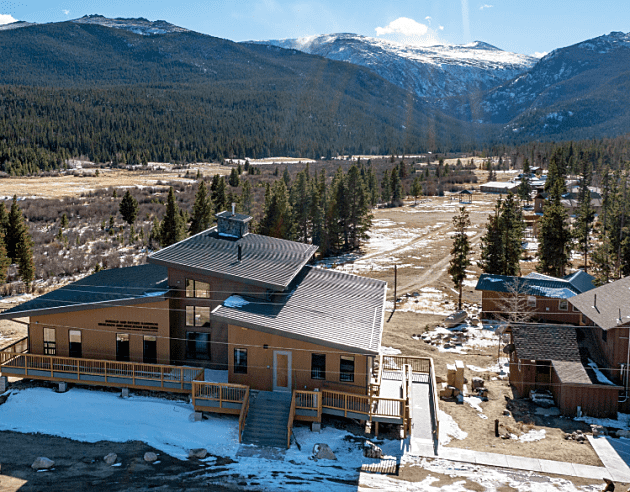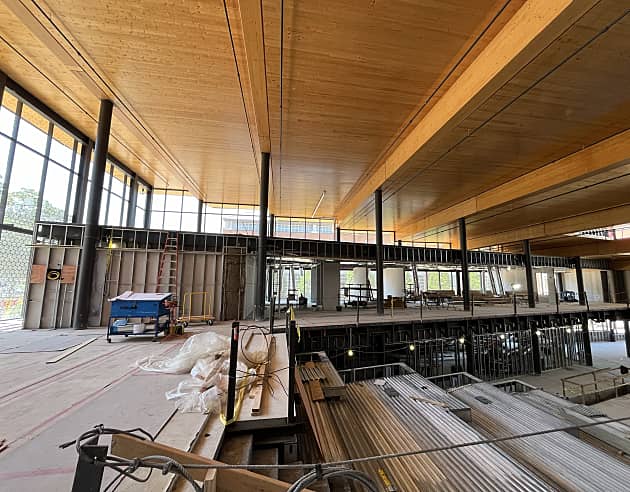- Project uploaded by Jordyn McCoy on 10-02-2024
- Project last updated by WoodWorks on 03-07-2025
Amy Gutmann Hall Data Science Building
Philadelphia, PAHousing Penn Engineering’s data science research and academic programs, Amy Gutmann Hall – named for the university’s longest-serving president – is a vibrant and welcoming hub for cross-disciplinary collaborations focused on harnessing the power of data and AI. Located on the site of a former parking lot, the building centralizes resources that will advance the work of scholars across a wide variety of fields, making the tools and concepts of data analysis and AI more accessible to the Penn community.
Amy Gutmann Hall is the tallest new mass timber building in the Philadelphia region, and, at six stories high and 116,000 square feet, one of the largest mass timber structures on the East Coast. The cutting-edge system significantly reduces the building’s carbon footprint – by 52% relative to concrete, and 41% relative to steel – and reinforces its identity as a beacon of innovation. The design connects occupants, who work in a digital realm, back to the natural world by maximizing views and daylight, integrating ecological environments into interior spaces, and incorporating sensory stimuli that encourage collaboration and comfort.
The facility houses three floors of teaching labs, active learning classrooms, and collaboration spaces as well as three floors of research centers. The ground floor serves as a home base for data science and AI programming with a gracious student commons and an honor cafe, a quiet reading room, collaboration spaces, and a large lecture hall. The two-story main entrance features a green wall, mass timber structure, natural and stained wood finishes, a balcony, and an intimate reading room. Connecting students and researchers on the third floor, a data science and AI hub encourages researchers from across campus and the private sector to gather through programs and events.
Anchored by open kitchenettes, a series of two-story spaces connect the upper three floors of research neighborhoods, fostering a building-wide sense of connectivity. Teams are aggregated in large, flexible neighborhoods of 35-40 researchers that link to adjacent labs through shared collaboration zones. In these neighborhoods, opportunities for creative collisions and informal, serendipitous conversations support a shared sense of vibrancy and innovation. A larger kitchen and break room, located on the fifth floor, serve the entire research community and host community events.
The building’s sustainable design features include a high-performance envelope and cooling and heating systems, which reduce the building’s energy consumption by nearly 20%, while low-flow plumbing fixtures and fittings reduce indoor water usage by 33%. High-performance windows and skylights provide balanced daylighting and views throughout, with more than 77% of regularly occupied spaces offering views to nature. A 12,000-square-foot green roof minimizes the building’s heat island effect and impact on wildlife habitats. The frit pattern on the curtainwall marries biomorphic patterns with computational design, further reinforcing the building’s identity. The project is targeting LEED Gold certification.
Project Details
-
Year Built
2024
-
Number Of Stories
6
-
Bldg system
Mass Timber
-
Sq. Meters
10,776
-
Construction Type:
III-A
-
Building Type:
Educational
-
Material Types:
Mass Timber
Glue-Laminated Timber (GLT or glulam)
Hybrid (wood with steel or concrete)
Project Team
-
DCI Engineers Owner Structural Review
-
Buro Happold Structural Engineer
-
Gilbane General Contractor
-
KSS Local Architect
-
Lake|Flato Architects Architect of Record; Design Architect
- Project uploaded by Jordyn McCoy on 10-02-2024
- Project last updated by WoodWorks on 03-07-2025



 WOODWORKS
INNOVATION
NETWORK
WOODWORKS
INNOVATION
NETWORK




